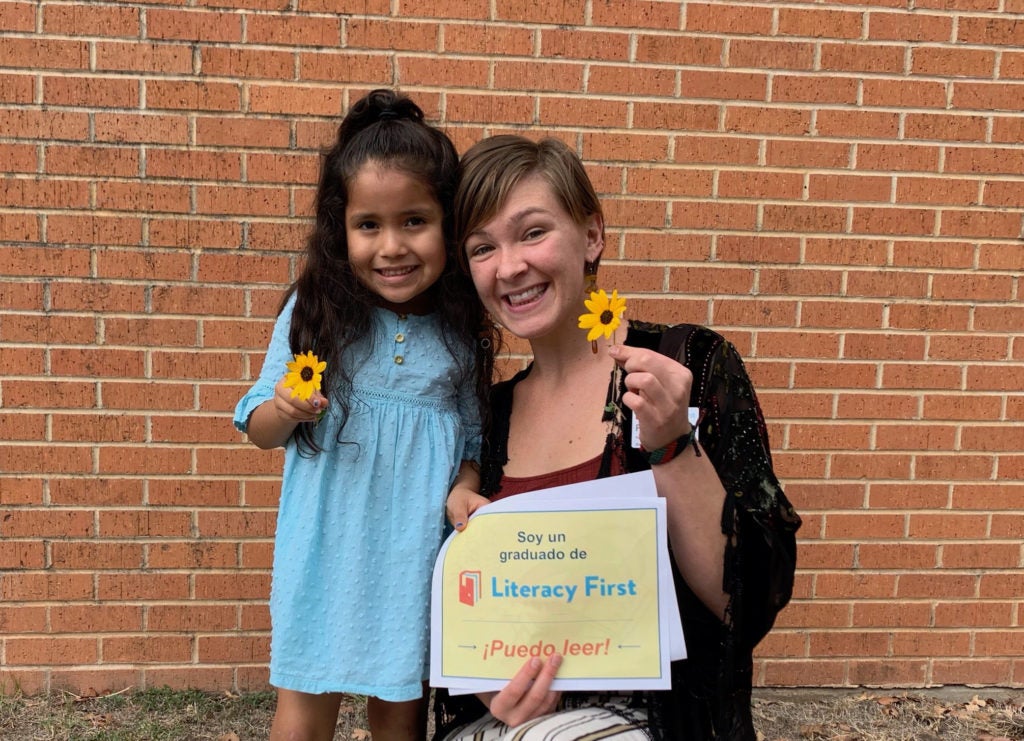By Rachel Peterson, 2019-2020 Literacy First Tutor

Teaching children to read has become a beautiful passion of mine.
I read the other day about passion, and the word had such connotations of suffering attached to it until recently. Now the entirety of us is concerned with finding their passion. So if it means to suffer a bit before being swept away in awe of how grandly important this is, teaching children to read certainly has become a passion of mine.
The undertaking has been more difficult than one can imagine. It isn’t simply placing a book in front of a child and reading to them and magically they absorb the information and can read back to you. Sometimes you can spend an entire week of sessions, a month of sessions, or months really, working the same material, not understanding why the child cannot grasp the concept of letter sounds melting together into words. It can be enormously frustrating, so the elements of patience and kindness are critical to our job.
However, beyond patience and kindness lies another component that I wasn’t aware of in the beginning. When I work with a child who struggles to read, I am rooting for them. We go over the passage for fluency, and after I model the passage, it is their turn. The timer is set for one minute, and I am counting the words they get correct in this minute. If I see a word coming up that I know they have struggled with in the past, it’s almost as if I am holding my breath. All of me cheers for the child: “You know this! We’ve worked on this! You can do it! Please please please!” And if they get it right, well, I feel a flood of pride for them. And if they get it wrong, it is my job to not let any feeling of disappointment come over my face, even if for 30 times, we went over the word together. Disappointment shocks me in those moments. However, there is never an appropriate time to let a child see that. Instead, we go over 31 times the word. It has rearranged the idea of failure in my mind. Failure at this level, does not exist unless the child gives up, and even then, I know that tomorrow they will try again.
They say that feedback to a child needs to be immediate and specific. To this, I agree. However, I believe that it is important for a teacher to take their own self out of the picture. Perhaps that is where the disappointment and pride come from, because I see it as a reflection of my teaching abilities. Crucial to teaching is the realization that it is not about me at all. Rather, it is about the children. Yes, one can be more invested in teaching, but if the child’s brain has not clicked the difference between “g” and “c”, then that isn’t a reflection of teaching ability.
Teaching a child to read can be related to climbing a mountain or training for a marathon or even planting a seed. You will not see the results of the seed for years. You cannot go from walking around your house to running twenty-seven miles or summiting Mt. Everest. The path a teacher walks is arduous and curvy, and you may never see the impact of your efforts. However, I feel so beautifully fulfilled in knowing that the work I undertake with a child will unfold continuously like a ripple effect throughout their lives and throughout my own life. We do not walk this path because we are immediately rewarded. We walk this path because we know ultimately that it leads to a better life for all involved.
The suffering of this passion is tremendous and unending patience. The joy that comes from cultivating patience and kindness shines bright through any situation. And one doesn’t need to be very patient for a child’s smile, because that comes easily, and that makes the task of teaching all the better. Not to mention the endless supply of books that are available, stories they can be transformed by, material that they know how to comprehend that is necessary, like taxes, documents, signs, the knowledge that literacy changes someone’s entire world. These solidify my passion of teaching children to read.

